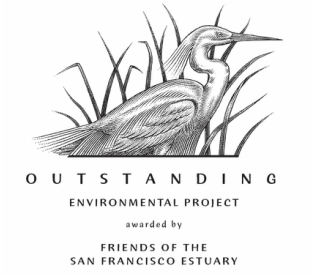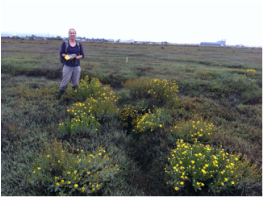2015 Outstanding Environmental Project Awardees
|
Six outstanding environmental projects that benefit the San Francisco Bay-Delta Estuary and its watersheds were honored at the 12th biennial State of the Estuary Conference on September 18, 2015, at the Downtown Oakland Marriott Hotel. The six awardees are:
1) Antioch Dunes Restoration Project 2) Breuner Marsh Restoration and Public Access Project 3) Cullinan Ranch Restoration Project 4) Invasive Spartina Treatment and Revegetation Project 5) San Francisco Bay Living Shorelines Project 6) South Bay Creeks Collaborative Read below for further information on these projects. |
Antioch Dunes Restoration Project
The Antioch Dunes Restoration
Project involves the use of material dredged from the Stockton Deep Water Ship Channel to help restore the
Refuge’s dune ecosystem. Site
preparation began in 2013 and, to date, approximately 50,000 cubic yards of
sandy dredged material have been placed onsite.
Dune replenishment is expected to continue for at least seven more years. The project is already showing signs of
success, as the butterfly population has nearly doubled, and other ecosystem
benefits are expected in the near future.
|
|
Cullinan Ranch Restoration Project
The Cullinan Ranch Restoration Project site, part of the San Pablo Bay National Wildlife Refuge, was diked and drained in the late 1800s for agriculture operations. In 1991, the Fish and Wildlife Service purchased the property for restoration.
In January 2015, the project restored tidal action to some 1,200 acres of diked tidal marsh. An additional 290 acres will receive nearly three million cubic yards of dredged material for beneficial re-use in the next few years to create near-term marsh plain habitat for the salt marsh harvest mouse and Ridgway’s rail. Once complete, the project will have restored a total of 1,500 acres of tidal marsh. |
Invasive Spartina Treatment and Revegetation Project
In 2000, the State Coastal Conservancy and USFWS initiated the Invasive Spartina Project. The goal of the project, which includes more than 50 partners, is to eradicate the invasive Spartina species in order to protect the long-term health of the native marsh ecosystem and to restore affected habitats. This species (Spartina alterniflora) invades mudflats and marshes and degrades conditions for native plants and animals. Along with three other non-native cordgrass species that occur in the Bay, it has caused a variety of habitat changes and associated adverse impacts to endangered species.
Between 2005 and 2014, the project eliminated more than 775 net acres of invasive Spartina from more than 25,000 acres of infested tidal marsh and 25,000 acres of mudflats. |
San Francisco Bay Living Shorelines Project
This project constructed native oyster and eelgrass beds in San Francisco Bay as part of a habitat restoration and climate change adaptation pilot project. It involved the placement of structures at the San Rafael Shoreline and at the Eden Landing Ecological Reserve. The project seeks to implement some of the regional goals established for subtidal habitats in the Bay. Preliminary project results are promising, as data show that the reefs are accreting sediment and reduce wave energy by up to 50 percent. More than two million native oysters have settled at the San Rafael site, along with juvenile Dungeness crabs, bay shrimp, and many other species of fish, birds and wildlife. |
South Bay Creeks Collaborative
Over the past five years, a collection of San Jose community groups has joined with agencies to clean up major creeks in the South Bay, especially Coyote Creek and Los Gatos Creek. Nearly a dozen partnering organizations are involved in this effort, with funding provided by the City of San José, Santa Clara Valley Water District and USEPA.
These groups have engaged thousands of volunteers from neighborhoods, corporations, and schools to clean up the creeks and begin to restore them. Collaboration with San Jose State University faculty has expanded the capacity of the groups through the development of journal articles and videos, the creation of an ensemble performance on homelessness and the creeks, and by organizing and hosting a Creeks Conference. The Project also offers work experience and leadership, and opportunities to earn community service hours. |









